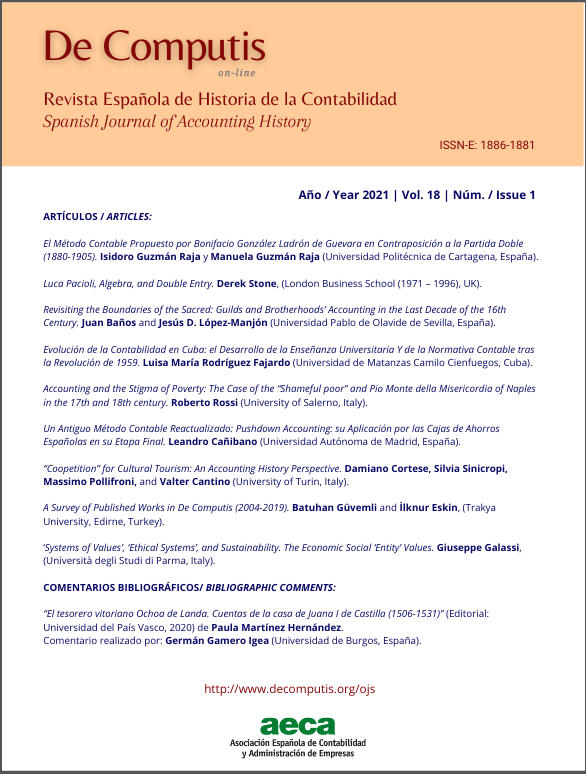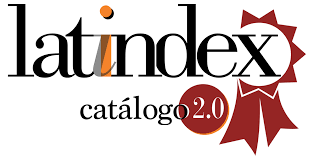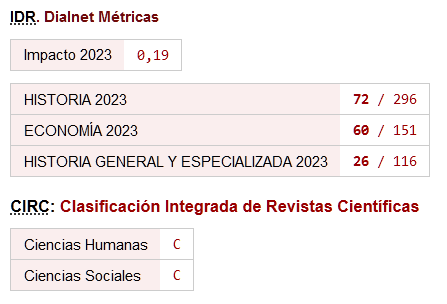“Coopetition” for Cultural Tourism
An Accounting History Perspective
DOI:
https://doi.org/10.26784/issn.1886-1881.v18i1.425Palabras clave:
Accounting History, Cultural heritage, Cultural tourism, UNESCO, Egyptian MuseumResumen
This research proposes an accounting history perspective on “coopetition”—a competitive approach
based on cooperation—in the cultural tourism sector. The analysis is based on the International Museums
Campaigns proclaimed by UNESCO in 1956 and 1957 and investigates the contribution of the Egyptian
Museum of Turin, in the context of the local tourism system, in constructing an event and its related
communication campaign. The purpose is to highlight, through accounting documents, the importance of
coopetition in stimulating visitors’ presence and reaching higher shared socio-economic results.
Descargas
Citas
Anderson, A. R., & Hardwick, J. (2017). Collaborating for innovation: the socialised management of knowledge. International Entrepreneurship and Management Journal, 13(4), 1181-1197. https://doi.org/10.1007/s11365-017-0447-6
Antonelli, V., & D'Alessio, R. (2014). Accounting history as a local discipline: The case of the Italian-speaking literature (1869-2008). Accounting Historians Journal, 41(1), 79-111. https://doi.org/10.2308/0148-4184.41.1.79
ASTo - Archivio di Stato di Torino (1831), Archivio della Soprintendenza speciale alle antichità egizie, busta 3, fasc. 3
Barney, J. B., & Arikan, A. M. (2001). The resource-based view: Origins and implications. The Blackwell handbook of strategic management, 124-188.
Baskerville, R., Carrera, N., Gomes, D., Lai, A., & Parker, L. (2017). Accounting historians engaging with scholars inside and outside accounting: Issues, opportunities and obstacles. Accounting History, 22(4), 403-424. https://doi.org/10.1177/1032373217732349
Bouncken, R. B., Gast, J., Kraus, S., & Bogers, M. (2015). Coopetition: a systematic review, synthesis, and future research directions. Review of Managerial Science, 9(3), 577-601. https://doi.org/10.1007/s11846-015-0168-6
Briassoulis, H. (2017). Tourism destinations as multiplicities: The view from Assemblage Thinking. https://doi.org/10.1002/jtr.2113
International Journal of Tourism Research, 19(3), 304-317. https://doi.org/10.1002/jtr.2113
Carnegie, G. D., & Napier, C. J. (2017). The accounting, auditing & accountability journal community in its 30th year. Accounting, Auditing & Accountability Journal. https://doi.org/10.1108/AAAJ-12-2016-2804
Curto, S., & Centro studi piemontesi (Torino). (1976). Storia del Museo egizio di Torino. Centro studi piemontesi.
Czakon, W., & Czernek-Marszałek, K. (2020). Competitor Perceptions in Tourism Coopetition. Journal of Travel Research, 0047287519896011. https://doi.org/10.1177/0047287519896011
Czakon, W., Klimas, P., & Mariani, M. (2020). Behavioral antecedents of coopetition: A synthesis and measurement scale. Long Range Planning, 53(1), 101875. https://doi.org/10.1016/j.lrp.2019.03.001
Donadoni-Roveri, A. M. (Ed.). (1989). Dal museo al museo: Passato e futuro del Museo egizio di Torino. Allemandi. European Parliament (2011). Regulation (EU) No 692/2011 of the European Parliament and of the council of 6 July 2011 concerning European statistics on tourism and repealing Council Directive 95/57/EC.
Favre-Bonté, V., & Thévenard-Puthod, C. (2013). The Role of Resources and Skills Transfer in the Performance of Acquisitions: the Acquired Firm's Perspective (No. hal-00959517). https://doi.org/10.1111/emre.12014
Fong, V. H. I., Wong, I. A., & Hong, J. F. L. (2018). Developing institutional logics in the tourism industry through coopetition. Tourism Management, 66, 244-262. https://doi.org/10.1016/j.tourman.2017.12.005
Gambino, G. (2020). Antonio De Bellis. Revista Eviterna, (8), 51-70. https://doi.org/10.24310/Eviternare.vi8.9781
Gomes, D., Carnegie, G. D., Napier, C. J., Parker, L. D., & West, B. (2011). Does accounting history matter?. Accounting History, 16(4), 389-402. https://doi.org/10.1177/1032373211417993
Guion, L. A. (2002). Triangulation: Establishing the validity of qualitative studies. https://doi.org/10.32473/edis-fy394-2002
Halme, M. (2001). Learning for sustainable development in tourism networks. Business strategy and the Environment, 10(2), 100-114. https://doi.org/10.1002/bse.278
Haugland, S. A., Ness, H., Grønseth, B. O., & Aarstad, J. (2011). Development of tourism destinations: An integrated multilevel perspective. Annals of tourism research, 38(1), 268-290. https://doi.org/10.1016/j.annals.2010.08.008
Jeacle, I. (2018). Accounting and entertainment. Accounting History, 23(3), 440-440. https://doi.org/10.1177/1032373218781350
Lai, A., & Samkin, G. (2017). Accounting history in diverse settings-an introduction. https://doi.org/10.1177/1032373217713062
McWatters, C. S. (2017). Historians but not necessarily so. https://doi.org/10.1080/21552851.2017.1415406
Lavie, D. (2006). The competitive advantage of interconnected firms: An extension of the resource-based view. Academy of management review, 31(3), 638-658. https://doi.org/10.5465/amr.2006.21318922
Levant, Y., & Zimnovitch, H. (2017). Epistemology and management science: Is accounting history still a legitimate subject of study?. Accounting History, 22(4), 450-471. https://doi.org/10.1177/1032373217730087
Liu, B., Huang, S. S., & Fu, H. (2017). An application of network analysis on tourist attractions: The case of Xinjiang, China. Tourism Management, 58(1), 132-141. https://doi.org/10.1016/j.tourman.2016.10.009
Luthe, T., Wyss, R., & Schuckert, M. (2012). Network governance and regional resilience to climate change: empirical evidence from mountain tourism communities in the Swiss Gotthard region. https://doi.org/10.1007/s10113-012-0294-5
McCabe, S., Sharples, M., & Foster, C. (2012). Stakeholder engagement in the design of scenarios of technology-enhanced tourism services. Tourism Management Perspectives, 4, 36-44. https://doi.org/10.1016/j.tmp.2012.04.007
McKercher, B. (2017). Do attractions attract tourists? A framework to assess the importance of attractions in driving demand. International Journal of Tourism Research, 19(1), 120-125. https://doi.org/10.1002/jtr.2091
Miller, P., & Power, M. (2013). Accounting, organizing, and economizing: Connecting accounting research and organization theory. The Academy of Management Annals, 7(1), 557-605. https://doi.org/10.5465/19416520.2013.783668
Moiso, B. (2016). La storia del Museo egizio. Fondazione Museo delle antichità egizie di Torino.
Napier, C. J. (2002). The historian as auditor: facts, judgments and evidence. Accounting Historians Journal, 29(2), 131-155. https://doi.org/10.2308/0148-4184.29.2.131
Novani, S., Putro, U. S., & Hermawan, P. (2015). Value orchestration platform: promoting tourism in batik industrial cluster solo. Procedia-Social and Behavioral Sciences, 169(1), 207-216. https://doi.org/10.1016/j.sbspro.2015.01.304
Pacelli, V. (1977). New documents concerning Caravaggio in Naples. The Burlington Magazine, 119(897),819-829.
Peters, M., Siller, L., & Matzler, K. (2011). The resource-based and the market-based approaches to cultural tourism in alpine destinations. Journal of Sustainable Tourism, 19(7), 877-893. https://doi.org/10.1080/09669582.2010.547198
Rodríguez-Díaz, M., & Espino-Rodríguez, T. F. (2008). A model of strategic evaluation of a tourismdest ination based on internal and relational capabilities. Journal of travel research, 46(4), 368-380. https://doi.org/10.1177/0047287507308324
Seow, A. N., Choong, Y. O., & Ramayah, T. (2020). Small and medium-size enterprises' business performance in tourism industry: the mediating role of innovative practice and moderating role of government support. Asian Journal of Technology Innovation, 1-21.
https://doi.org/10.1080/19761597.2020.1798796
Symbola-Unioncamere (2018). Io sono cultura - 2018. L'Italia della qualità e della bellezza sfida la crisi (2018), http://www.symbola.net/html/article/iosonocultura2018
van der Zee, E., & Vanneste, D. (2015). Tourism networks unravelled; a review of the literature on networks in tourism management studies. Tourism Management Perspectives, 15, 46-56. https://doi.org/10.1016/j.tmp.2015.03.006
UNESCO (1997). Glossary of World Heritage Terms. WHC.
Vergori, A. S., & Arima, S. (2020). Cultural and non-cultural tourism: Evidence from Italian experience. Tourism Management, 78,104058. https://doi.org/10.1016/j.tourman.2019.104058
Wang, Y., & Fesenmaier, D. R. (2007). Collaborative destination marketing: A case study of Elkhart county, Indiana. Tourism Management, 28(3), 863-875. https://doi.org/10.1016/j.tourman.2006.02.007
Weber, M. (2005). Economia e società. Comunità (Vol. 31). Donzelli Editore.
Williams, G. (2020). Future potential of economic impact assessment. Impact Assessment and Project Appraisal, 38(4), 272-277. https://doi.org/10.1080/14615517.2019.1684097
Wu, Y. C., Lin, S. W., & Wang, Y. H. (2020). Cultural tourism and temples: Content construction and interactivity design. Tourism Management, 76, 103972. https://doi.org/10.1016/j.tourman.2019.103972
Zhang, X., & Song, H. (2017). An integrative framework for collaborative forecasting in tourism supply chains. International Journal of Tourism Research 2017, 1-14. https://doi.org/10.1002/jtr.2168
Descargas
Publicado
Cómo citar
Número
Sección
Licencia

Esta obra está bajo una licencia internacional Creative Commons Atribución-NoComercial-CompartirIgual 4.0.










